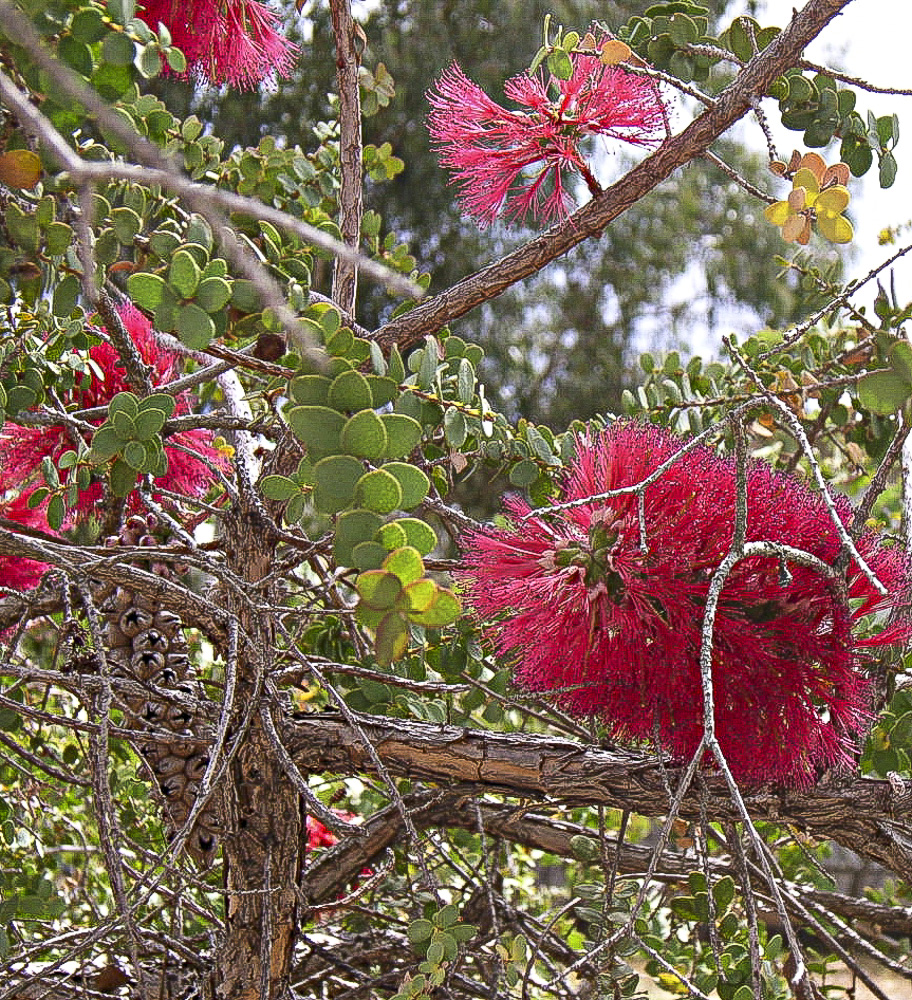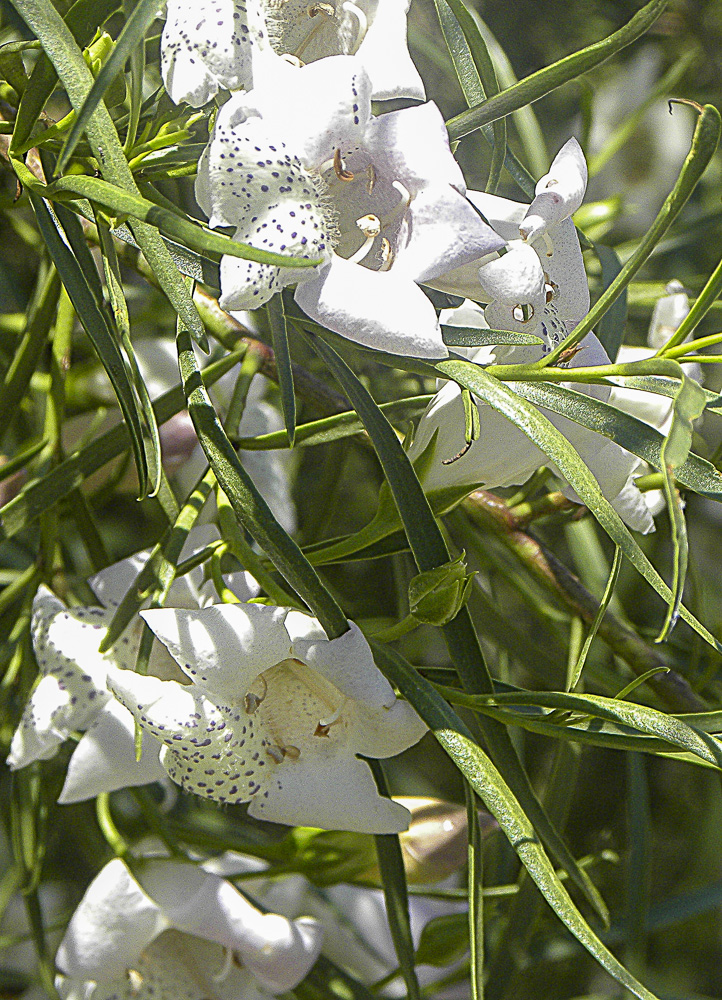This article is part of a two part series – this one was written in 2008 and the second in 2024. See Part 2 for the 2024 update here.
Our property ‘Eagles Drift’ is situated in the Upper Hunter Valley at the junction of the Goulburn and Krui Rivers.
When my husband and I moved to this beautiful property of 574 hectares 19 years ago, there was a four-roomed dilapidated house full of rats and spiders with a wire netting fence hugging a minute yard . The whole area was surrounded by the most beautiful natural environment imaginable, with river flats for cattle grazing.
The small house yard, comprising a great vegie patch and lots of weeds, was quickly extended to about 1.5 ha with an easterly to north easterly aspect.

In my mind’s eye I envisaged a large natural bush garden to complement the surrounding craggy mountains and natural vegetation which form part of our property and to provide habitat for the many wild creatures which pass from the hills to the nearby river.
I commenced planting grevilleas, wattles, melaleucas and callistemons.. That year (1989) it rained virtually non-stop for three months and all the young plants did well.


Then the rain ceased and the first of our droughts set in! We knew little about the growing of Australian plants and didn’t bother to care for them and gradually they died from heat stress and lack of water.
The soil consisted of solid black alluvial clay and it set like cement after the rain Our frustration increased and we eyed off our neighbours’ stunning roses and daffodils and very temporarily toyed with similar ideas!!!
The inspiring factor was that during bush-walks on our property we found many beautiful wildflowers and shrubs on the rocky slopes and gullies, and we studied the conditions under which they were thriving (in spite of the dry conditions). My husband has a scientific background and his expertise enables us to more easily identify local species.
We gradually started building up the garden beds with bush sand and leaf litter to a height of about half a metre. Within a couple of months everything we planted began to flourish.
A design on paper has never taken place. Building up sandy garden beds became an obsession and they started meandering around the yard like a maize.
I have since become more discerning about the species of plants especially in view of years of ongoing hot, dry summer weather (up to 45 degrees C.) with freezing conditions in winter (sometimes with 30 x -6 degree C.frosts at a time).
The species that are thriving with minimum care are:
• Acacia decora (local species)
• Banksia marginata (local species)
• Brachyscombe multifida
• Callistemon pinifolius (local species)
• Chrysocephelum apiculatum (local species)
• Correa alba; C. ‘Federation Belle’
• Dichondra repens (self sown – excellent weed suppressant)
• Einadia sp. Ruby salt bush (self-sown and a useful ground cover)
• Eremophila maculata; E. ‘Summertime Blue‘; E. polyclada
• Eucalyptus lansdowneana; E. leucoxylon
• Grevillea johnsonii – grafted (local endangered species; G. montana (local endangered species)
• Lomandra longifolia (local species)
• Melaleuca thymifolia (local species)
• Myoporum debile (local species); M. floribundum; M. montanum (local species); M. purpureum
• Scaevola humilis
The most amazing drought resistant plants listed above are the eremophilas (as their name implies they thrive in dry conditions) and as a bonus they seem to cope with any soil-types. Those in our garden have become widespread and dense and when flowering are a popular haven for small birds such as blue-wrens, white cheeked honey eaters, pardalotes, silver-eyes etc.
Fertiliser and mulch
I rarely apply fertiliser to the garden (just occasionally Seasol on new plants) and now and then mulch with old paddock hay, with more of the garden now becoming self mulching with its own leaf-litter.
To my delight the contractor who checks the power lines on farming properties had a full load of mulched eucalypt prunings when he reached our gate – he apologetically asked if he could off- load somewhere and he was hastily directed to our garden. What a bonus and what a great benefit it has been to the garden. I initially used rocks and gravel to mulch some areas, but find that while the plants are young they die from radiated heat.
Pests and pruners
Insect pests are no problem, especially with so many birds making use of the dense foliage. We do have other creatures that enjoy digging up and demolishing some plants.
A large family of white-winged choughs regularly aerates the mulch and underlying soil on the edges of gardens, and a few hand-raised wombats and their wild nocturnal friends delight in eating struggling clumps of kangaroo grass and dianella. We welcome the wildlife in spite of their foraging. What a privilege to be sharing this space with them.
Garden design
I read every book I can on designing with Australian plants and drool over the snippets on ABC Gardening Australia and other TV programmes. My time is very limited for gardening and so the area has become a bit of a wilderness with meandering pathways with shrubs and groundcovers, and even more haphazard areas happily congested with wattles thriving and dying alongside eucalypts and melaleucas, intertwined with hardenbergias.
I try to repeat the same plants, so that there is a sense of continuity, but encourage little surprises to be tucked under taller shrubs. I still battle with weeds, anything from Pattersons curse to thistles, and when the weather is very very hot and dry and the only green shoot is a weedy one, I look on them favourably.
One delight of our garden is the view from the kitchen window of swaying branches close to the verandah (Callistemon citrinus ‘Endeavour’) with contrasting foliage packed into gardens behind (Eremophila polyclada and Eremophila ‘Summertime Blue’, E. maculata), and a glimpse of paths disappearing down the slope beckoning us outside to count the birds and our blessings.




We then gaze up into the hills with huge old eucalypts, rock overhangs and imagine we can see the original occupants of this land flitting through the shadows.
Inspiration
Many books have given me inspiration in developing our garden, but the following I have enjoyed immensely:
• A Bush Calendar by Amy Mack
• A Bush Garden by Esther Wetherill
• Back from the Brink by Peter Andrews
• Australian Native Gardens, Putting Visions into Practice by Diana Snape
• The Australian Garden, Designing with Australian Plants by Diana Snape
I have tried to encourage others to include Australian species in their gardens, and a few years ago I was successful in persuading the local show to include a class for Australian native flowers in the floral display section. I entered a rather haphazard arrangement of flowers from Acacia vestita, Boronia ledifolia, Grevillia triloba, Eucalyptus leucoxolyn and E. maculata (foliage) and much to my surprise my display won grand champion that year and in the two subsequent years!
Since writing this article we have experienced flooding rains, more dry conditions, few frosts and unseasonably warm weather. We brace ourselves for the varying climatic conditions ahead, but meanwhile continue to pursue our passion.
Jenny wrote an addendum to this article in January 2024. See here for Part 2.
 Australian Native Plants Society (Australia)
Australian Native Plants Society (Australia)